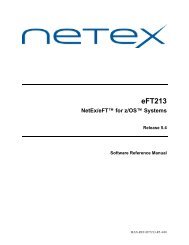Software Reference Manual - NetEx
Software Reference Manual - NetEx
Software Reference Manual - NetEx
Create successful ePaper yourself
Turn your PDF publications into a flip-book with our unique Google optimized e-Paper software.
FORTRAN Entry<br />
The entry to the record module should be declared as shown in Figure 17<br />
SUBROUTINE rmod (BUF,BUFLEN,BUFLEV,MSG,MSGLEN,MSGLEV,<br />
+ RPARM,MODE,DDNAME)<br />
type BUF(1)<br />
INTEGER*4 BUFLEN,BUFLEV,MSGLEN,MSGLEV,MODE<br />
CHARACTER*128 MSG<br />
CHARACTER*64 RPARM<br />
CHARACTER*8 DDNAME<br />
. FORTRAN Record Module Entry Parameters<br />
Figure 17. FORTRAN Record Module Entry Parameters<br />
The following parameters appear in Figure 17<br />
rmod<br />
This parameter is the record module name.<br />
BUF<br />
This parameter specifies the start of the logical record information. For a receiving record module,<br />
the logical record information will start at the beginning of the BUF array. For a sending record<br />
module, the record should be placed starting at the beginning of the BUF array.<br />
BUFLEN<br />
BUFLEV<br />
This parameter specifies the length of the logical record in bytes. When the record module is called<br />
for the first time, BUFLEN will have the maximum logical record length permissible with the user’s<br />
BLOCK parameter. If the record module decides this value it can change the value of BUFLEN (and<br />
hence the BFX buffer size) before returning to the block module. On subsequent calls, the receiving<br />
record module will obtain the logical record length in this parameter. Sending block modules should<br />
specify the length of the outgoing record with this variable.<br />
This parameter specifies a binary number that contains the delimiter level of the record to be sent or<br />
accepted. This is a binary value in the range of 0 to 15. Normally, this value is one to indicate the<br />
normal end of a logical record. A value of 15 indicates that this record is to be the last record transferred,<br />
referred to as End of Information in the BFX specifications. Intermediated values are used by<br />
computer operating systems that have a hierarchy of end delimiters in their file structure, such as the<br />
EOR, EOF, and EOI indications in CDC CYBER data files.<br />
BUFLEV has a second use: to signal when the record module is entered for the first time. On that<br />
first entry, BUFLEV will have a value of -1. On all other entries, it will have a value greater than or<br />
equal to zero. Thus BUFLEV < 0 can be used as a conclusive test for first time (initialization) entry<br />
to the record module.<br />
If the record module is receiving data, then BUFLEV will contain the delimiter level of the file delimiter<br />
following the record provided in BUF. A record may or may not accompany this delimiter; if it<br />
does not, then BUFLEN will be set to zero. If the passed BUFLEV is 15, then this will be the last<br />
Page 60 Appendix A: User Modules MAN-REF-H211-05















